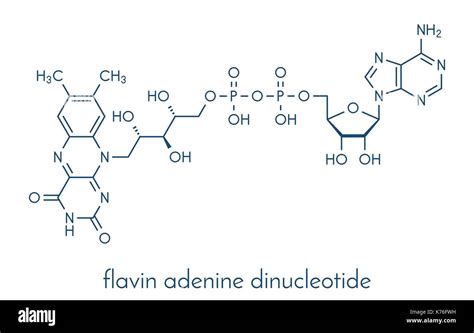Flavin adenine dinucleotide, commonly referred to as FAD, is a crucial redox-active coenzyme that plays a pivotal role in various biochemical processes. As a derivative of riboflavin, also known as vitamin B2, FAD is essential for the transfer of electrons in a wide range of enzymatic reactions. Its significance is underscored by its involvement in the metabolism of carbohydrates, fats, and proteins, making it a vital component of cellular respiration and energy production.
Structure and Properties of FAD

The molecular structure of FAD consists of a flavin group, an adenine moiety, and two phosphate groups, which are linked together to form a dinucleotide. This complex structure enables FAD to participate in redox reactions, where it can exist in three different oxidation states: the fully oxidized state (FAD), the semiquinone state (FADH·), and the fully reduced state (FADH2). The ability of FAD to undergo reversible oxidation and reduction makes it an indispensable coenzyme in numerous biological processes.
Biological Functions of FAD
FAD is involved in a multitude of biological reactions, including the citric acid cycle, fatty acid oxidation, and the electron transport chain. In these processes, FAD acts as an electron carrier, facilitating the transfer of electrons from one molecule to another. This electron transfer is essential for the generation of ATP, the primary energy currency of the cell. Moreover, FAD is a cofactor for various enzymes, such as succinate dehydrogenase, which plays a critical role in the citric acid cycle, and acyl-CoA dehydrogenase, which is involved in the beta-oxidation of fatty acids.
| Enzymatic Reaction | Role of FAD |
|---|---|
| Succinate Dehydrogenase | Electron transfer in the citric acid cycle |
| Acyl-CoA Dehydrogenase | Electron transfer in fatty acid oxidation |
| Electron Transport Chain | Generation of ATP through electron transfer |

Deficiency and Disorders Related to FAD

A deficiency in FAD or its precursors can lead to various disorders, including riboflavin deficiency, which can cause symptoms such as cracks in the corners of the mouth, inflammation of the tongue, and seborrheic dermatitis. Additionally, genetic disorders that affect the synthesis or metabolism of FAD, such as multiple acyl-CoA dehydrogenase deficiency, can have severe consequences, including muscle weakness, cardiomyopathy, and even death.
Therapeutic Applications of FAD
The significance of FAD in biological processes has led to its exploration as a therapeutic agent in various diseases. For instance, FAD has been investigated as a potential treatment for conditions such as cancer, neurodegenerative diseases, and mitochondrial disorders. Its role in energy metabolism and electron transfer makes it an attractive target for the development of novel therapeutic strategies.
Key Points
- FAD is a redox-active coenzyme essential for various biochemical processes, including energy metabolism and electron transfer.
- Its structure consists of a flavin group, an adenine moiety, and two phosphate groups, enabling it to participate in reversible oxidation and reduction reactions.
- FAD is involved in numerous biological reactions, including the citric acid cycle, fatty acid oxidation, and the electron transport chain.
- A deficiency in FAD or its precursors can lead to various disorders, including riboflavin deficiency and genetic disorders affecting FAD synthesis or metabolism.
- FAD has been explored as a therapeutic agent in various diseases, including cancer, neurodegenerative diseases, and mitochondrial disorders.
In conclusion, FAD is a vital coenzyme that plays a central role in various biological processes, including energy metabolism and electron transfer. Its significance is underscored by its involvement in numerous enzymatic reactions and its potential as a therapeutic agent in various diseases. Further research into the mechanisms and applications of FAD is essential to fully understand its importance and to harness its therapeutic potential.
What is the primary function of FAD in biological processes?
+The primary function of FAD is to act as an electron carrier, facilitating the transfer of electrons in various enzymatic reactions, including the citric acid cycle, fatty acid oxidation, and the electron transport chain.
What are the consequences of a FAD deficiency?
+A deficiency in FAD or its precursors can lead to various disorders, including riboflavin deficiency, multiple acyl-CoA dehydrogenase deficiency, and other genetic disorders affecting FAD synthesis or metabolism.
What are the potential therapeutic applications of FAD?
+FAD has been explored as a potential treatment for conditions such as cancer, neurodegenerative diseases, and mitochondrial disorders, due to its role in energy metabolism and electron transfer.


